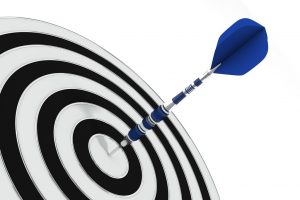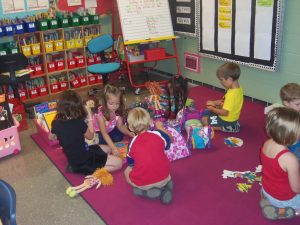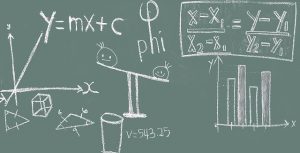4 Mathematics Standards
Janet Stramel

Standards describe what students are expected to learn in each grade and each subject. Each state Department of Education creates standards for schools within the state. These standards become the basis for the way teachers are trained, what they teach and what is on state standardized tests that students take. Without standards, districts and schools don’t have goals. By matching what is taught in the classroom to the standards in each subject area, students will know what teachers should be teaching, what students should be learning, and what they will be tested on (GreatSchools Staff, 2012).
As an early childhood teacher, you need to be familiar with three sets of standards: the Kansas Early Learning Standards, the Kansas Mathematics Standards, and the Standards for Mathematical Practice.

Kansas Early Learning Standards
The Kansas Early Learning Standards were first completed in 2006 with a second revision done in 2009 and updated in 2014. The standards are aligned with the K-12 College and Career Ready Standards and provide information and guidance to early childhood providers and teachers, including early primary grade teachers, on the developmental sequence of learning for children from birth through kindergarten promoting continuity between early childhood years and the primary grades (K-3). It is a dynamic resource that providers and teachers will be able to use as they plan activities for and engage in conversations with young children and their families around early learning.
The Kansas Early Learning Standards are “statements describing the skills and knowledge that young children, ages birth through five, should know and be able to do as a result of participating in high quality early childhood programs. This knowledge and ability provides the foundation for future success in kindergarten and later in life. Such continuity can facilitate smooth transitions and clarify communication between programs both vertically and horizontally. This alignment with K-12 supports school readiness as well as school success” (KSDE, 2014).
Kansas Early Learning – Mathematics Knowledge
Research shows that young children can do mathematics and solve problems. Long before entering school, young children explore and use mathematics and do it naturally. Children at play begin to learn essential math skills such as counting, equality, addition, subtraction, estimation, planning, patterns, classification and measurement. They compare, notice similarities and differences, and group toys and materials. This ability to organize information into categories, quantify data and solve problems helps children learn about time, space and numbers. Over time, they develop the vocabulary and skills to:
- Measure,
- Describe patterns,
- Express order and position, and
- Describe relationships between objects in the
environment.
Mathematics helps children make sense of the physical and social worlds around them and they naturally incorporate math as they make comments such as:
- “He has more than I do!”
- “That won’t fit in there, it’s too big.”
- “I can’t move it, it’s too heavy.”
Organization of the Kansas Early Learning Standards
The Kansas Early Learning Standards – Mathematics Knowledge are categorized into four domains:
- Counting and Cardinality
- Operations and Algebraic Thinking
- Measurement and Data
- Geometry
The mathematics content is divided by age levels: Young Infant (by 8 months), Mobile Infant (by 18 months), Toddler (by 36 months); Pre 3 (by 48 months), Pre 4 (by 60 months), and Kindergarten (by the end of K).

Kansas Mathematics Standards
The Kansas Mathematics Standards were adopted by the State Board of Education in August 2017. These Standards define what students should understand and be able to do in mathematics. Asking a student to understand something means asking a teacher to assess whether the student has understood it. But what does mathematical understanding look like? One hallmark of mathematical understanding is the ability to justify, in a way appropriate to the student’s mathematical maturity, why a particular mathematical statement is true or where a mathematical rule comes from. The Standards set grade-specific standards but do not define the methods or materials necessary to support students.
The Kansas Mathematics Standards provide information on what students should know and be able to do at different grade levels in mathematics. These standards are guidelines school districts can use to develop their mathematics curriculum. They are not the curriculum. In Kansas, each school district develops its own mathematics curriculum and teachers decide on how they will provide instruction to ensure student’s learning of mathematics.
Organization of the Kansas Mathematics Standards
There are two sets of standards; content standards and the Standards for Mathematical Practice.
The standards for mathematical content are focused on number and quantity, algebra, functions, geometry, modeling, and statistics and probability. For kindergarten through grade 8, the content standards are organized by grade levels. The 9-12 standards do not use grade bands, but instead have broad conceptual categories. All content standards are organized by Domain, Cluster, and then Standards.
Domains are larger groups of related standards. The Domain is the big idea.
Clusters are groups of related standards. At the beginning of each cluster, the bold label is referred to as the Cluster Heading
Standards define what students should understand and be able to do.
You can access the Kansas Mathematics Standards here.
Kansas Mathematics Standards K-8
Domains are descriptions of the mathematical content to be learned. These are elaborated through clusters and standards.
Clusters may appear in multiple grade levels in the K-8 Common Core. There is increasing development as the grade levels progress. Clusters begin with a content statement. For example, in grade 1, “Extend the counting sequence.”
Standards are what students should know and be able to do at each grade level. The standards reflect both mathematical understandings and skills, which are equally important. For example, in grade 1, “Count to 120 (recognizing growth and repeating patterns), starting at any number less than 120. In this range, read and write numerals and represent a number of objects with a written numeral.” (1.NBT.1)
The Kansas Mathematics Standards document is intended to be a resource to teachers. The document is interactive: hyperlinks are in blue font and underlined and red words are roll-over words. Hovering over the word provides a definition of the term identified. In addition, the Learning Progressions are referenced throughout the document.
There is no substitute for reading the standards yourself. Read the Kansas Mathematics Standards.
Standards for Mathematical Practice
The Standards for Mathematical Practice (SMPs) describe varieties of expertise that mathematics teachers at all levels should seek to develop in their students. The SMPs represent the habits of mind that represent thinking and understanding.
Standards for Mathematical Practice
- Make sense of problems and persevere in solving them.
- Reason abstractly and quantitatively.
- Construct viable arguments and critique the reasoning of others.
- Model with mathematics.
- Use appropriate tools strategically.
- Attend to precision.
- Look for and make use of structure.
- Look for and express regularity in repeated reasoning.
© Copyright 2010. National Governors Association Center for Best Practices and the Council of Chief State School Officers. All rights reserved.
What do the Standards for Mathematical Practice Mean?

SMP1: Make sense of problems and persevere in solving them means to understand the problem, find a way to solve the problem, and work until it is done. Your students will basically be using this first SMP in every mathematics problem, every day. In order to help your students “make sense of problems and persevere in solving them,” allow wait time for yourself and your students. Work for progress and “aha” moments. Mathematics becomes about the process and not about the one right answer. Lead with questions, but don’t pick up a pencil and do the problem for your students.
This means that sometimes your students will struggle. This is called “productive struggle,” which is the process of effortful learning that develops grit and creative problem-solving. When students come across a problem they don’t know how to solve, we don’t want them to give up. Instead, we want our students to make connections to what they already know, and try different ways of solving a problem. Read more about Productive Struggle at the Renaissance website.

SMP2: Reason abstractly and quantitatively means to break apart a problem and show it symbolically, in pictures, or in any way other than the standard algorithm. This means that students can contextualize and decontextualize a problem. Students can understand the relationships between problems and mathematical representations, as well as how the symbols represent strategies for solution. If students have a problem, they should be able to break it apart and show it symbolically, with pictures, or in any way other than the standard algorithm. Conversely, if students are working on a problem, they should be able to apply the math to the situation.
Help your students “reason abstractly and quantitatively” by asking your students to draw representations of problems. Be sure to have lots of manipulatives for your students to access. Or let your students decide what to do with data themselves instead of telling them the type of graph to use. Pose purposeful questions that will lead your students to a conceptual understanding. Or ask your students to draw their thinking, with and without traditional number sentences.

SMP3: Construct viable arguments and critique the reasoning of others means that your students will be able to talk about mathematics, using mathematical language and vocabulary to support or oppose the work of others.
Teachers can help students “construct viable arguments and critique the reasoning of others” by posting mathematical vocabulary and expect students to use it. Encourage student discourse, and make sure that your classroom environment is a safe place for students to share and discuss ideas.

SMP4: Model with mathematics means to solve real-world problems, organize data, and understand the world around you. This SMP is often misinterpreted. It is not about manipulatives, but about the symbols and expressions that represent a situation. Math limited to the math class is worthless. Help your students “model with mathematics” by having them use math in other classes, such as science, art, music, and reading. Include real graphs, articles, and current data to make the mathematics relevant and real, or have your students create real-world problems using their mathematical knowledge. You can promote student thinking by asking, “What is happening here?” and “How can I represent this with mathematical expressions?”
You can learn more about this SMP from Robert Kaplinsky’s website.

SMP5: Use appropriate tools strategically means students can select the appropriate math tools to use, and use that tool correctly to solve problems. Don’t tell your students which tool to use; leave that decision open-ended and then discuss what worked best and why. Tools do not necessarily need to be so much about the real situation but rather about the mathematical situation presented.
Teachers can help their students “use appropriate tools strategically” by providing manipulatives to assist in developing students’ mathematical thinking. Encourage your students to draw or use a model to identify how the problem responses may be alike or different.
The Sadlier Math Blog has some great ideas for manipulatives at the different grade levels.

SMP6: Attend to precision means that students speak and solve mathematics problems with exactness and precision. Encourage your students to use precise mathematical language. This SMP is more than just a correct solution; it is also about communicating clearly and precisely using mathematical language.
To help your students “attend to precision” ask them to use precise and exact mathematical language. Their measurements should be exact, their numbers should be precise, and their explanations must be detailed.

SMP7: Look for and make use of structure means to find patterns and repeated reasoning that can help students solve more complex problems. For young students, this could mean recognizing fact families, inverses, or mathematical properties.
“Use of structure” means . . . what is going on in the math that allows you to apply the equations or symbols or to draw the diagram you can draw. It is the outline of what’s going on in the situation.
Help your students “look for and make use of structure” by asking them to identify multiple strategies and then select the best one. Repeatedly break apart numbers and problems into different parts. Use what you know is true to solve a new problem. Prove solutions without relying on the algorithm. For example, my students are changing mixed numbers into improper fractions. They have to prove to me that they have the right answer without using the “steps.”
This SMP applies what we know about general rules to specific situations . . . deductive reasoning (properties, definitions, characteristics of the math, relationships between the quantities, and explanations of why certain things are happening).

SMP8: Look for and express regularity in repeated reasoning means looking at the big picture while working on the details of the problem. This SMP extends our thinking beyond just a simple repeating pattern; it encourages students to ask, “Where does this repetition lead you in terms of making a generalization to other situations?”
One way to help your students “look for and express regularity in repeated reasoning” is to show students how the problem works. As soon as they “get it,” ask them to generalize to a variety of problems. Don’t ask your students to work 50 of the same problem; instead, ask them to take their mathematical reasoning and apply it to other situations.
The description of this SMP includes patterns but extends our thinking beyond just a simple repeating pattern or number pattern. It’s a broader look at patterning; repetition in procedures and thinking. Encourage student reflective questioning. Ask, “Where does this repetition lead you in terms of making generalizations to other situations?” or “If we have many examples of something that are somehow the same, what can we learn from that?”
Find SMPs in the Kansas Mathematics Standards, pages 9–13, or in the blue box at the beginning of each grade level. Also note the summary of the SMPs and questions to ask your students that will help develop these habits of mind. In addition, you can find more about SMPs at the Common Core State Standards for Mathematics website.
Learning Progressions
Included with the Kansas Mathematics Standards document are references to the learning progressions. These progressions describe the progression of a mathematical topic across grade levels. In addition, they are linked throughout the standards to provide insight into the content standards.
All learning progressions can be found at the KSDE website.
The Kansas Early Learning Standards, the Kansas Mathematics Standards, the Standards for Mathematical Practice, and the Learning Progressions all provide clarity and specificity to the mathematics we teach. As you plan lessons, you will need to know the standards that define what students should know and be able to do at each grade level.
larger groups of related standards. Domains are the big idea.
groups of related standards
define what students should understand and be able to do
taking the abstract mathematical representation and putting into context
taking a context and representing it abstractly



